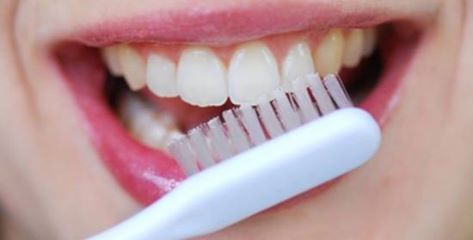
Toothbrushing plays an important everyday role for personal oral hygiene and effective plaque removal. Appropriate toothbrush care and maintenance are also important considerations for sound oral hygiene. The ADA recommends that consumers replace toothbrushes approximately every 3–4 months or sooner if the bristles become frayed with use.
In recent years, scientists have studied whether toothbrushes may harbor microorganisms that could cause oral and/or systemic infection. We know that the oral cavity is home to hundreds of different types of microorganisms; therefore, it is not surprising that some of these microorganisms are transferred to a toothbrush during use. It may also be possible for microorganisms that are present in the environment where the toothbrush is stored to establish themselves on the brush. Toothbrushes may even have bacteria on them right out of the box4since they are not required to be sold in a sterile package.
The human body is constantly exposed to potentially harmful microbes. However, the body is normally able to defend itself against infections through a combination of passive and active mechanisms. Intact skin and mucous membranes function as a passive barrier to bacteria and other organisms. When these barriers are challenged or breached, active mechanisms such as enzymes, digestive acids, tears, white blood cells and antibodies come into play to protect the body from disease.
Although studies have shown that various microorganisms can grow on toothbrushes after use, and other studies have examined various methods to reduce the level of these bacteria, there is insufficient clinical evidence to support that bacterial growth on toothbrushes will lead to specific adverse oral or systemic health effects.
General Recommendations for Toothbrush Care
The ADA and the Council on Scientific Affairs provide the following toothbrush care recommendations:
Do not share toothbrushes. Sharing a toothbrush could result in an exchange of body fluids and/or microorganisms between the users of the toothbrush, placing the individuals involved at an increased risk for infections. This practice could be a particular concern for persons with compromised immune systems or existing infectious diseases.
Thoroughly rinse toothbrushes with tap water after brushing to remove any remaining toothpaste and debris. Store the brush in an upright position if possible and allow the toothbrush to air-dry until used again. If more than one brush is stored in the same holder or area, keep the brushes separated to prevent cross-contamination.
Do not routinely cover toothbrushes or store them in closed containers. A moist environment such as a closed container is more conducive to the growth of microorganisms than the open air.
Replace toothbrushes at least every 3–4 months. The bristles become frayed and worn with use and cleaning effectiveness will decrease.11 Toothbrushes will wear out more rapidly depending on factors unique to each patient. Check brushes often for this type of wear and replace them more frequently if needed. Children’s toothbrushes often need replacing more frequently than adult brushes.
Additional Comments
Cleaning methods beyond those outlined above are not supported by the currently available clinical evidence. While there is evidence of bacterial growth on toothbrushes, there is no clinical evidence that soaking a toothbrush in an antibacterial mouth rinse or using a commercially-available toothbrush sanitizer has any positive or negative effect on oral or systemic health. Some toothbrush cleaning methods, including use of a dishwasher or microwave oven, could damage the brush. Manufacturers may not have designed their products to withstand these conditions. The cleaning effectiveness of the brush might be decreased if it is damaged.
Although there is insufficient clinical evidence to support that bacterial growth on toothbrushes will lead to specific adverse oral or systemic health effects, a common-sense approach is recommended for situations where patients may be at higher risk to infection or re-infection by various microbes. Examples may include situations where a patient or family member:
- Has a systemic disease that may be transmissible by blood or saliva;
- Has a compromised immune system or low resistance to infection due to disease, chemotherapy, radiation treatment, etc.
Common-sense supports that for patients who are more susceptible to infections, a higher level of vigilance to prevent exposure to disease-causing organisms may offer some benefit.
- Replacing toothbrushes more often than every 3–4 months may decrease the number of bacteria to which patients are exposed;
- Rinsing with an antibacterial mouth rinse before brushing may prevent or decrease how rapidly bacteria build up on toothbrushes;2
- Soaking toothbrushes in an antibacterial mouth rinse after use has also been studied and may decrease the level of bacteria that grow on toothbrushes;6
- Disposable toothbrushes might also be considered as an option, however cost may be a consideration with long-term use.
- There are several commercially available toothbrush sanitizers on the market. Although data do not demonstrate that they provide a specific health benefit, if a consumer chooses to use one of these devices, the Council recommends that they select a product cleared by the Food and Drug Administration (FDA). Products cleared by the FDA are required to provide data to the Agency to substantiate cleared claims. Examples of claims that have been cleared by the FDA for these products include:
- Product “X” is designed to sanitize manual toothbrushes (To “sanitize” normally means that bacteria are reduced by 99.9 percent. For example, if one million bacteria are present at the outset, 1000 bacteria remain after a 99.9 percent reduction. “Sterilized”, on the other hand, indicates that all living organisms have been destroyed or inactivated. No commercially-available toothbrush cleaning products have been shown to sterilize toothbrushes);
- Product “Y” is intended for use in reducing bacterial contamination that naturally accrues on toothbrushes.
